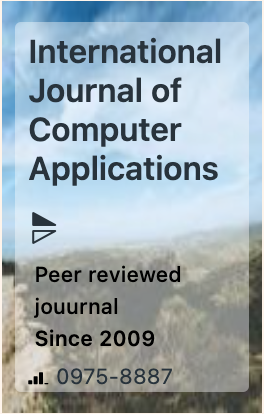The week's pick
Random Articles
Reseach Article
An Improved Intrusion Detection Scheme in a Smart Home Environment
| International Journal of Computer Applications |
| Foundation of Computer Science (FCS), NY, USA |
| Volume 186 - Number 74 |
| Year of Publication: 2025 |
| Authors: Samuel Mtswenem Vanen, Sever Kwaghbee, Vershima Iyorter, Tivlumun Ge, Adekunle Adedotun Adeyelu |
 10.5120/ijca2025924607
10.5120/ijca2025924607
|
Samuel Mtswenem Vanen, Sever Kwaghbee, Vershima Iyorter, Tivlumun Ge, Adekunle Adedotun Adeyelu . An Improved Intrusion Detection Scheme in a Smart Home Environment. International Journal of Computer Applications. 186, 74 ( Mar 2025), 42-53. DOI=10.5120/ijca2025924607
Abstract
The fast increase in the number of Internet of Things (IoT) devices in smart homes makes them more exposed to cybersecurity threats. In turn, this creates an urgent need for robust intrusion detection systems. This study proposes an IoT Smart Home Multi User Access Control Intrusion Detection System (SHMUACIDS), with a view to improving the security by more efficiently detecting anomalies. It was designed based on a multi-layer architecture that consists of a Packet Capture Layer, a Feature Extraction Layer, the Machine Learning Model, and the Alerting System, all knitted together to work in tandem for proactively meeting the security challenges in IoT smart home environments. Intrusion Detection Data were obtained from kaggle website containing list of simulated TCP/IP connections were employed in training different machine learning models. The methodology also embeds digital signatures and proper key management, data integrity countermeasures together with an alert system which immediately notifies administrators on the detected anomalies. Results indicated that SHMUACIDS considerably outperformed the detection of anomalous activities in smart home IoT environments compared to some classical methods and previous studies. This holistic approach makes SHMUACIDS competitive in the smart home cybersecurity landscape.
References
- Ali, O., Ishak, M. K., Bhatti, M. K. L., Khan, I., & Kim, K. I. (2022). A Comprehensive Review of Internet of Things: Technology Stack, Middlewares, and Fog/Edge Computing Interface. Sensors, 22(3), 995.
- Salem, R., Aidaros, B., & Belqasmi, F. (2024, April). Sustainable Industrial Agriculture in the UAE: Leveraging IoT and AI Technologies. In 2024 15th Annual Undergraduate Research Conference on Applied Computing (URC) (pp. 1-6). IEEE.
- Asghari, P., Rahmani, A. M., & Javadi, H. H. S. (2019). Internet of Things applications: A systematic review. Computer Networks, 148, 241-261.
- Mohiuddin, M., Hosseini, E., Tajpour, M., & Bahman-Zangi, B. (2024). Internet of Thing (IOT) Based Sensor Technologies and Smart Irrigation System: An Analysis of Critical Success Factors in Emerging Markets. The Journal of Developing Areas, 58(4), 167-188.
- Nag, A., Hassan, M. M., Das, A., Sinha, A., Chand, N., Kar, A., ... & Alkhayyat, A. (2024). Exploring the applications and security threats of Internet of Thing in the cloud computing paradigm: A comprehensive study on the cloud of things. Transactions on Emerging Telecommunications Technologies, 35(4), e4897.
- Elrawy, M. F., Awad, A. I., & Hamed, H. F. (2018). Intrusion detection systems for IoT-based smart environments: a survey. Journal of Cloud Computing, 7(1), 1-20.
- Jose, S. C. S., Singh, S. K., Rathore, S., & Park, J. H. (2020). A comprehensive analyses of intrusion detection system for IoT environment. Journal of Information Processing Systems, 16(4), 975-990.
- Abdulganiyu, O. H., Tchakoucht, T. A., & Saheed, Y. K. (2024). Towards an efficient model for network intrusion detection system (IDS): systematic literature review. Wireless Networks, 30(1), 453-482.
- Kumari, A., Tanwar, S., Tyagi, S., & Kumar, N. (2018). Fog computing for Healthcare 4.0 environment: Opportunities and challenges. Computers & Electrical Engineering, 72, 1-13.
- Heidari, A., & Jabraeil Jamali, M. A. (2023). Internet of Things intrusion detection systems: a comprehensive review and future directions. Cluster Computing, 26(6), 3753-3780.
- Restuccia, F., D’Oro, S., & Melodia, T. (2018). Securing the internet of things in the age of machine learning and software-defined networking. IEEE Internet of Things Journal, 5(6), 4829-4842.
- Giri, A., Dutta, S., Neogy, S., Dahal, K., & Pervez, Z. (2017, October). Internet of Things (IoT) a survey on architecture, enabling technologies, applications and challenges. In Proceedings of the 1st International Conference on Internet of Things and Machine Learning (pp. 1-12).
- Rejeb, A., Rejeb, K., Treiblmaier, H., Appolloni, A., Alghamdi, S., Alhasawi, Y., & Iranmanesh, M. (2023). The Internet of Things (IoT) in healthcare: Taking stock and moving forward. Internet of Things, 22, 100721.
- Ali, B., & Awad, A. I. (2018). Cyber and physical security vulnerability assessment for IoT-based smart homes. sensors, 18(3), 817.
- Muaadh S. A., Razak, S., Siraj, M. M., Nafea, I., Ghaleb, F. A., Saeed, F., & Nasser, M. (2021). Anomaly-based intrusion detection systems in iot using deep learning: A systematic literature review. Applied sciences, 11(18), 8383.
- Lirim, M., & Cihan D. (2021). Network intrusion detection system using deep learning. Procedia Computer Science, 185, 239-247.
- Alsulami, R., Alqarni, B., Alshomrani, R., Mashat, F., & Gazdar, T. (2023). IoT Protocol-Enabled IDS based on Machine Learning. Engineering Technology & Applied Science Research, 13(6), 12373–12380. https://doi.org/10.48084/etasr.6421
- Janardhana, D. R., Kumar, V. P., Lavanya, S. R., & Manu, A. P. (2021, November). Detecting security and privacy attacks in iot network using deep learning algorithms. In 2021 IEEE International Conference on Distributed Computing, VLSI, Electrical Circuits and Robotics (DISCOVER) (pp. 35-40). IEEE.
- Almotairi, A., Atawneh, S., Khashan, O. A., & Khafajah, N. M. (2024). Enhancing intrusion detection in IoT networks using machine learning-based feature selection and ensemble models. Systems Science & Control Engineering, 12(1).
- Abdullah, S., Rehman, A., Qureshi, M. A., Ali, T., Irfan, M., Yasin, S., ... & Węgrzyn, M. (2021). Smart Fire Detection and Deterrent System for Human Savior by Using Internet of Things (IoT). Energies, 14(17), 5500.
- Sikder, A. K., Babun, L., Celik, Z. B., Acar, A., Aksu, H., McDaniel, P., ... & Uluagac, A. S. (2020, July). Kratos: Multi-user multi-device-aware access control system for the smart home. In Proceedings of the 13th ACM Conference on Security and Privacy in Wireless and Mobile Networks (pp. 1-12).
- Ravidas, S., Lekidis, A., Paci, F., & Zannone, N. (2019). Access control in Internet-of-Things: A survey. Journal of Network and Computer Applications, 144, 79-101.
- Li, H., Han, D., & Chang, C. C. (2023). DAC4SH: A Novel Data Access Control Scheme for Smart Home Using Smart Contracts. IEEE Sensors Journal, 23(6), 6178-6191.
- Mohammad, Z. N., Farha, F., Abuassba, A. O., Yang, S., & Zhou, F. (2021). Access control and authorization in smart homes: A survey. Tsinghua Science and Technology, 26(6), 906-917.
- Qiu, J., Tian, Z., Du, C., Zuo, Q., Su, S., & Fang, B. (2020). A survey on access control in the age of internet of things. IEEE Internet of Things Journal, 7(6), 4682-4696.
- El Sibai, R., Gemayel, N., Bou Abdo, J., & Demerjian, J. (2020). A survey on access control mechanisms for cloud computing. Transactions on Emerging Telecommunications Technologies, 31(2), e3720.
- Xu, B., Sun, L., Mao, X., Ding, R., & Liu, C. (2023). IoT Intrusion Detection System based on Machine learning. Electronics, 12(20), 4289. https://doi.org/10.3390 /electronics12204289.
- Azizjon Ikromjon O ‘G‘Li, M. (2024). Iot Network Intrusion Detection System Using Machine Learning Techniques. Kokand University Herald. https://doi.org/10.54613/ku.v11i11.972
- Verma, A., & Ranga, V. (2019). Machine learning based intrusion detection systems for IoT applications. Wireless Personal Communications, 111(4), 2287–2310. https://doi.org/10.1007/s11277-019-06986-8
- Saheed, Y. K., Abiodun, A. I., Misra, S., Holone, M. K., & Colomo-Palacios, R. (2022). A machine learning-based intrusion detection for detecting internet of things network attacks. Alexandria Engineering Journal, 61(12), 9395–9409. https://doi.org/10.1016/j.aej.2022.02.063
Index Terms
Keywords

